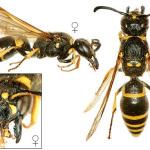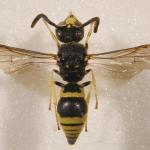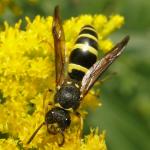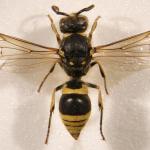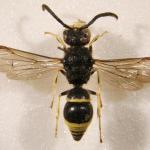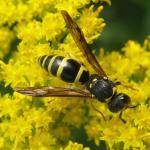Identification keys and general biology are given in Nielsen (1932), Spradbery (1973), Richards (1980) and Yeo & Corbet (1995).
Found throughout England and Wales (including the Isle of Man) and into Scotland north to Aberlour (Banffshire). Widely recorded in Ireland. There is one old record for the Channel Islands.
Overseas, found in many parts of mainland Europe (Norway, Sweden, Finland, Denmark, The Netherlands, France, Germany, Italy, Poland, Austria, Hungary, Greece and Bulgaria) and eastwards to central Asia and Japan.
The species is not regarded as being scarce or threatened.
Found in a variety of habitats. Often present in gardens and homes.
Probably univoltine; most likely to be seen during June and July, sometimes during May and August, and rarely in March, April and September.
Small Lepidoptera larvae.
A tube-dweller. Often nests in the stems of bramble and elder. Also recorded nesting in the central hole of a cotton reel, the gap between books and the back of a bookcase, and a hole in a wooden clothes line prop.
Sea-holly, bramble, hogweed and thistles.
Chrysis impressa Schenck and C. longula Abeille de Perrin (Morgan, 1984).
1998


